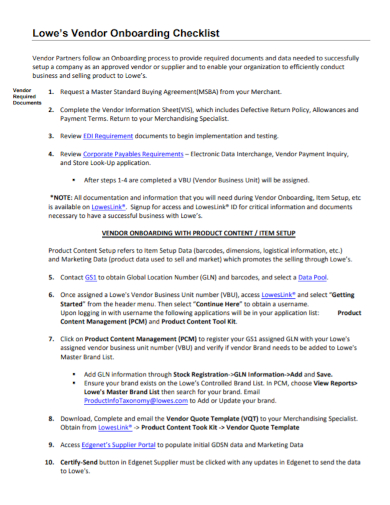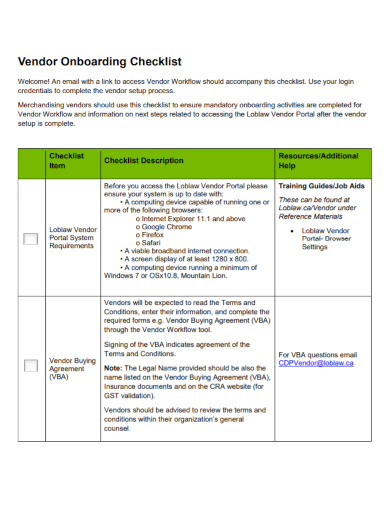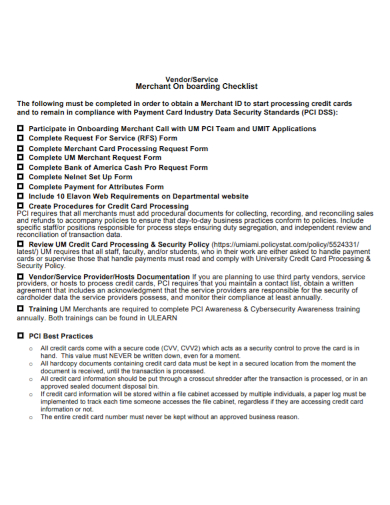An effective product or a good service would not be possible without a capable vendor or supplier. Businesses organize their management to help search for these potential business partners by first undergoing vendor evaluation and vendor risk which is part of the vendor onboarding process. Once a vendor has succeed a company’s expectation, a vendor partnership deal is made through vendor contract agreement. To know more, reading along this article and check some of our vendor onboarding checklist samples below:
3+ Vendor Onboarding Checklist Samples
1. Vendor Onboarding Checklist
2. Sample Vendor Onboarding Checklist
3. Standard Vendor Onboarding Checklist
4. Vendor Service Merchant Onboarding Checklist
What Is Vendor Onboarding?
Vendor Onboarding or Supplier Onboarding is a process whereas a business organization collects extensive information from potential vendors in order to be able to conduct business, purchase or help in the manufacturing of goods and fulfillment of service and lastly to transact payment. Searching for the right vendor requires a large amount of work and time, this is why companies are adamant to following the right procedure process.
How to Onboard a New Vendor?
As mentioned, the process of vendor or supplier selection is part of a comprehensive set of procedures which a vendor must undertake and ultimately the outcome will be highly advantageous. Here are the following steps to examine as you commence with the onboarding process.
I. Research
First to all, the business market is teeming with thousand of potential vendor candidates who can become a likely business partner. As a company, research and create a list on the list of vendors you think can be beneficial. Then gather information about products/services offered and commercial condition if these can align with your own company’s standards. As you narrow down your search, you can now start to evaluate each and everyone.
II. Evaluate
Once a list is organized, determine the guidelines for who you will and will not work with, and figure out the steps your team and the prospective vendors must take to move forward. Companies often times submit business proposals so every potential vendor can get an idea what is needed of the product or service and if they own company fit that bill.
III. Expectation and Requirements
Vendors also would convey their own expectations and set of requirements and see to it if this would align to your company’s own standards. Make sure the policies and expectations are clear from the beginning in order to reach a mutual understanding which will increase efficiency and reduce confusion and potential friction.
IV. Disseminate Information
Distribute the information regarding the vendor selection process to other concerned parties in the organization such as finance, sales, purchasing and etc. In this way should there be any objections, suggestions or clarifications additional input from these involving parties can be beneficial to the decision making process. Keep in mind, onboarding a vendor isn’t just the responsibility of one company division.
V. Vendor Approval
So you’ve weight in all your options, scrutinize each and every information that you have gathered. The company examines vendor proposals and assesses the risk so a decision has to be made. Formulate the pros and cons to ultimately come up with the decision. And since the responsibility of deciding does not fall into one person, make sure everyone part of the onboarding process are held responsible on the final output.
FAQs
What Is Strategic Partnership?
A strategic partnership is a business relationship between two entities that focuses on creating joint value for two or more organizations. These are usually formalized by one or more business contracts.
What Is a Supplier Risk Management?
Business organizations use this method to evaluate, track and measure third-party risk; to assess its impact on all aspects of your business; and to develop control measures or other forms of mitigation to lessen the impact on your business if something should happen.
What Is a Vendor Managed Inventory?
The vendor managed inventory is defined as an inventory management method which a supplier of goods, usually the manufacturer, is responsible for optimizing the inventory held by a distributor.
Without a good onboarding process, at best you may face reduced productivity and efficiency and at worst you risk losing valuable business due to poor training, management, or partner nurturing. Thus it is important that vendors are screened properly since they are going to be long time business partners and would play a big and critical role in a business’ productivity and revenue growth.
Related Posts
FREE 10+ Agreement Checklist Templates
FREE 10+ Plumbing Maintenance Checklist Samples
FREE 10+ Property Management Checklist Samples
FREE 10+ Trade Show Checklist Samples
Checklists to Boost Efficiency and Reduce Mistakes
FREE 10+ Planning for Retirement Checklist Samples
FREE 8+ Housekeeper Checklist Samples
FREE 7+ Equipment Checklist Samples
FREE 21+ Student Checklist Samples
FREE 20+ Monthly Checklist Samples
FREE 18+ Wedding Registry Checklists
FREE 10+ Monitoring Checklist Samples
FREE 10+ Exit Interview Checklist Samples
FREE 10+ Workplace Inspection Checklist Samples
FREE 8+ Change Management Checklist Samples




